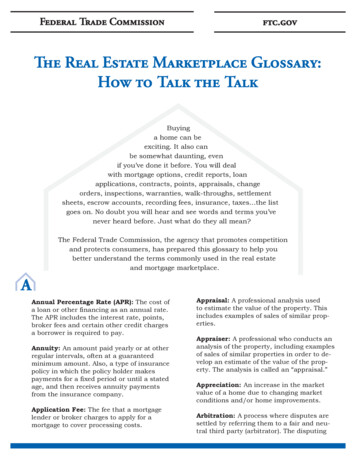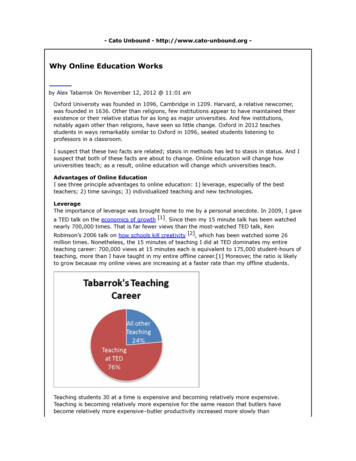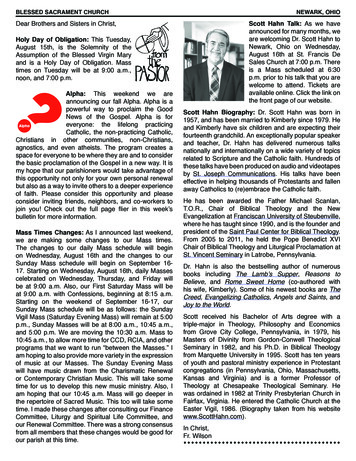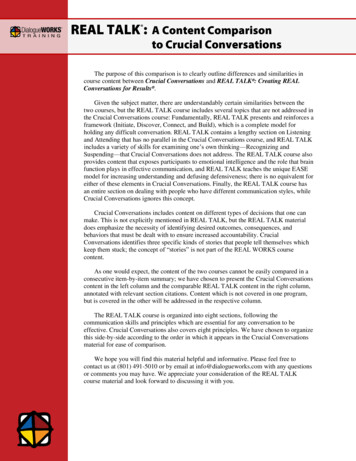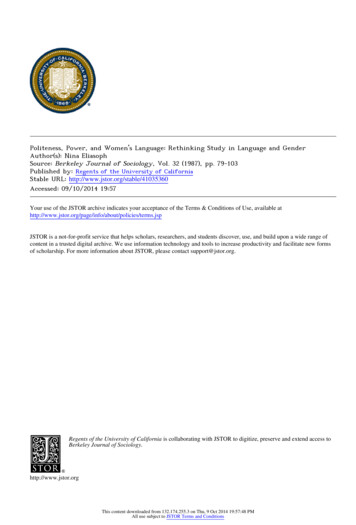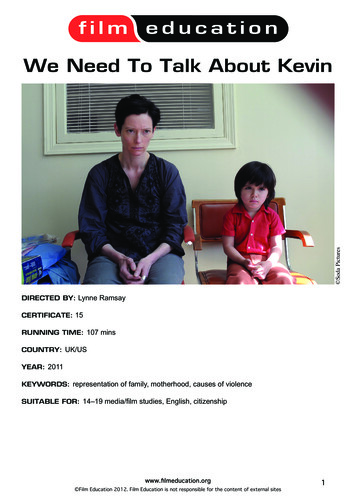
Transcription
Soda PicturesWe Need To Talk About KevinDirected by: Lynne RamsayCertificate: 15Running time: 107 minsCountry: UK/USYear: 2011Keywords: representation of family, motherhood, causes of violenceSuitable for: 14–19 media/film studies, English, citizenshipwww.filmeducation.org Film Education 2012. Film Education is not responsible for the content of external sites1
SYNOPSISEva is an outcast in her community. Her house is regularly vandalised, she is ignored at her joband she is routinely assaulted and verbally abused in the street. She reflects on the ruin her lifehas become and what she sees as the cause of her downfall – her son Kevin. From birth, Evaand Kevin’s relationship is strained and difficult, years of manipulation and indifference resultingin hatred. Eva’s husband Franklin believes Kevin to be a wonderful son, leading to tension intheir marriage. Kevin also appears to intimidate and harm his younger sister Celia. When Kevincommits a horrendous atrocity at his high school, Eva’s life is changed forever.Before ViewingWe Need To Talk About Kevin deals in part with the difficult subject of mass murder. Theseappalling crimes occasionally hit the headlines (most recently in The Dark Knight Rises shootingsin Colorado, US) and sometimes film, computer games and other media can be cited as influenceson the perpetrators. Films such as Child’s Play 3, Natural Born Killers and A Clockwork Orangehave been banned or withdrawn from distribution because of their alleged influence of real lifecrimes and killings. Some films (such as the New Zealand drama Out of the Blue, starringKarl Urban) have attempted to deal with the subject of mass murder and others particularly withhigh school massacres (like Bowling For Columbine and Elephant). Do you believe that films, computer games or other media could influence someone tocommit horrendous crimes? What are your reasons? What other factors might motivate someone to commit crimes such as these? Watch the following films or their trailers/selected sequences:Bowling For ColumbineElephantOut of the BlueBeautiful BoyWhat styles of filmmaking appear to be used to tackle the subject? Do any of the films appear tolay blame on anyone/anything?after viewingEditingDirector Lynne Ramsay and her editor Joe Bini have employed elliptical editing in We Need ToTalk About Kevin; scenes that occur years apart follow each other in different order – one minutewe see Eva alone in her house after the massacre, the next she is with Franklin before they havechildren, the next second the whole family is in the kitchen. This in some way reflects the way theoriginal novel was written – as a collection of letters written in the first person from Eva to Franklinthat recall different points in their lives. What effect does this editing style have on the viewer? What visual clues are there to tell the viewer that we are now at a different point in thestory? What other films have you seen that use this editing style?www.filmeducation.org Film Education 2012. Film Education is not responsible for the content of external sites2
KEVIN’S MOM – AN UNRELIABLE NARRATOR?A common device in literature and film is the ‘unreliable narrator’. When a book or film is narratedor told from one person’s (or several peoples) point of view, the protagonist’s explanation of eventscan be called into question. In film particularly, the unreliable narrator can be exposed throughstylised direction, acting or plot twists. This device is often used to intrigue, excite and shock theviewer and make them reconsider events they may previously consider true. While Eva doesn’tliterally narrate the film, events are definitely shown from her viewpoint. Popular film examples ofthe unreliable narrator include Barry Lyndon, Sunset Boulevard, American Psycho, Fight Club, TheUsual Suspects, Identity and The Sixth Sense. Can you think of any others? What clues are there in the film that events are being exaggerated or over-simplified andthat Eva is therefore an unreliable narrator? Consider the following aspects.Franklin’s attitude throughout the filmevents leading to Celia’s eye injuryKevin’s manipulative and cruel behaviour from such a young ageacting stylesmise en scèneEva’s culpabilityREPRESENTATIONS OF THE NUCLEAR FAMILYIt has been suggested that we currently live in a fractured society. Only twenty years ago therewere only four main UK TV channels, one household telephone and basic games consoles. Thewhole family gathering round the TV, especially at the weekends, and everyone being togetherfor an evening meal was commonplace. Today, there are so many TV channels, games consoles,handheld devices, websites, entertainment outlets and pressures on our time that families rarelyspend ‘quality’ time together, even when they’re all in the same house. Mum might be watchingTV while Dad is on the laptop; meanwhile one child is upstairs playing X-Box while the other ismessaging their friends on a mobile device. We Need To Talk About Kevin challenges the notion ofthe ideal nuclear family and suggests that lack of communication and failure to express feelings toone another may be part of the cause of problems within the average family. What do Eva and Franklin sacrifice in order to have children? On the rare occasions all four members of Eva’s family are together, how do theyinteract? Who seems to be ‘in charge’? Think about your own family. Do you ever spend a set time together? Do you find ithelpful to talk about issues you might have with each other or do things tend to get bottledup? What important things do Eva’s family not do that might have led to them falling apart? How has Kevin changed in the final scene? Consider costume, make-up, acting, plot anddialogue. What answers do Eva, the film or any other character offer in explanation for Kevin’sviolent acts?www.filmeducation.org Film Education 2012. Film Education is not responsible for the content of external sites3
Below are some suggested conventions of how family members are typically portrayed in film. Youmay disagree with some of the suggestions but that’s fine. To what extent to the family membersin this film fulfil the expected ces a lot forfamilylooks after the homeFathersover-workednot often at homesternprincipledpushy andcompetitive, especiallywith sonTeenage Sonfrustratedrebelliousinsularmoodyyearning forindependenceembarrassed byparentsYounger Daughterinnocenthappydelightfulfresh-faced and cutelooks up to parentsand older siblingsWould these descriptions accurately describe Eva and her family?“OUT DAMNED SPOT”! BLOOD ON EVA’S HANDSRed is a prevalent colour in the mise en scène. From the almost religious ecstasy of La TomatinaFestival in the opening scene, to Eva constantly scraping red paint off her house, and evenin mundane household objects, there is hardly a frame without red in it. Ironically, despite thehorrifying events in the film, barely any blood is actually shown – a characteristic shared withhorror classic The Texas Chain Saw Massacre. How might Eva be compared to Lady Macbeth? What notable red items or objects are seen throughout the film and what effect do thesehave? What does red signify in this film? Soda Pictures Other films in which red is important include Don’t Look Now, Schindler’s List and TheSixth Sense. What thematic importance does red have in these films? Can you think of anyfilms in which red (or any other colour) is used to signify themes or emotions?www.filmeducation.org Film Education 2012. Film Education is not responsible for the content of external sites4
ACTIVITIES1. Kevin is never seen during a normal day at his school. We do not learn of, nor do we see himinteracting with his teachers, peers or classmates. Write a diary entry by Kevin charting a day at school. Storyboard or shoot a ‘deleted scene’ showing Kevin on a normal day at school. Doeshe have friends? What might he say if anything? Challenge yourself to design the sequencefrom Eva’s perspective.2. In groups, argue to what extent the following factors may have led Kevin to commit the HighSchool atrocity. Use evidence from the film; but also consider factors the film may not haveincludedEvaFranklinpsychological imbalance/damagebullyingnature vs nurturecomputer gamesmodern society, culture and mediadivorce/family break-downRECOMMENDED FURTHER VIEWING Bowling For Columbine (Michael Moore, 2002) - a documentary about the ColumbineMassacre Out of the Blue (Robert Sarkies, 2006) – the true story of the Aramoana Massacre of1990, New Zealand’s deadliest mass murder Elephant (Gus Van Sant, 2003) – Palme D’or winning drama inspired by the ColumbineMassacre Beautiful Boy (Shawn Ku, 2010) – drama starring Michael Sheen and Maria Bello with anidentical premise to KevinWritten by Gareth C. Evanswww.filmeducation.org Film Education 2012. Film Education is not responsible for the content of external sites5
www.filmeducation.org Film Education 2012. Film Education is not responsible for the content of external sites 1 DirecteD by: Lynne Ramsay certificate: 15 running time: 107 mins country: UK/US year: 2011 KeyworDs: representation of family, motherhood, causes of violence suitable for: 14–19 media/film studies, English,


